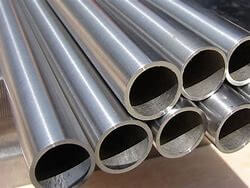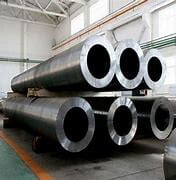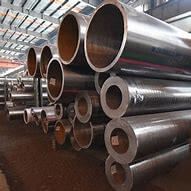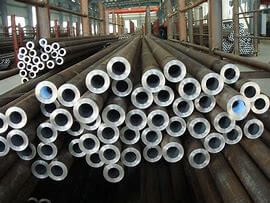Q235 plain carbon structural steel is also known as A3 steel.
Plain carbon structural steel – plain is a steel material.
Q stands for the yield limit of the material, followed by 235, which is the yield value of the material, around 235MPa. And will increase with the thickness of the material to make its yield value decreases, due to the moderate carbon content, comprehensive performance is better, strength, plasticity and welding and other properties to get a better match, the most widely used.
Basic introduction
Q235 ordinary carbon structural steel is also called A3 plate.
Common carbon structural steel – plain plate is a kind of steel material.
Q stands for the yield limit of this material, followed by 235, which is the yield value of this material, at about 235MPa. The yield value decreases as the thickness of the material increases (235MPa for plate thickness/diameter ≤ 16mm, 225MPa for plate thickness/diameter ≤ 40mm, 215MPa for plate thickness/diameter ≤ 40mm, 215MPa for plate thickness/diameter ≤ 60mm, 205MPa for plate thickness/diameter ≤ 100mm, 205MPa for plate thickness/diameter ≤ 100mm; 100mm < plate thickness / diameter ≤ 150mm, yield strength of 195MPa; 150mm < plate thickness / diameter ≤ 200mm, yield strength of 185MPa). Due to the moderate carbon content, the overall performance is better, strength, plasticity and welding properties to get a better match, the most widely used.
It is composed of Q + number + quality grade symbol + deoxidation method symbol. Its steel number is crowned with “Q”, representing the yield point of the steel, followed by a number indicating the yield point value in MPa, for example, Q235 means the yield stress (σs) of 235 MPa carbon structural steel.
If necessary, the steel number can be marked with a symbol indicating the quality level and deoxidation method. Quality grade symbols are A, B, C, D. Deoxidation method symbols: F boiling steel; b indicates semi-sedated steel: Z indicates sedated steel; TZ indicates special sedated steel, sedated steel may not be marked symbols, that is, Z and TZ are not marked. For example, Q235-AF indicates A grade boiling steel.
Special purpose carbon steel, such as bridge steel, marine steel, etc., basically using carbon structural steel, but in the steel number at the end of the additional letters indicating the use.
Mechanical properties
Density:7.85g/cm^3
Modulus of elasticity(E/Gpa):200~210
Poisson’s ratio(ν):0.25~0.33
Tensile strength(σb/MPa):370-500
Yield strength(thickness or diameter less than or equal to 16mm):235
Elongation(δ5/%):
≥26(a≤16mm)
≥25(a>16-40mm)
≥24(a>40-60mm)
≥23(a>60-100mm)
≥22(a>100-150mm)
≥21(a>150mm)
Where a is the thickness or diameter of the steel.
In the plate, is the most common material, belongs to the general plate series. In the past, it was called as:A3.
Execution standard: External standard is GB/T709-2006 “Size, shape, weight and allowable deviation of hot-rolled steel plates and strips”, internal standard is GB/T3274-2007 “Hot-rolled thick steel plates and strips of carbon structural steel and low-alloy structural steel”.
Classification
Usually rolled steel is mainly: coil or round steel, square steel, flat steel, angle steel, I-beam, channel steel, window frame steel and other sections, medium and thick steel plates.
Use
1、A large number of applications in the building and engineering structure. C and D grade steel can also be used as some professional steel.
2、It can be used for various mold handles and other unimportant mold parts.
3、The Q235 steel is used as punch material, and it is used directly without tempering after quenching, and the hardness is 36~40HRC, which solves the phenomenon that the punch is broken in use.
Indication method
The complete expression method is: Q235 – quality grade symbol – deoxidation method symbol quality grade A, B, C, D, E, in order to A grade quality is worse, D grade quality is the highest. The symbols of deoxidation methods are F, b, Z and TZ, which indicate boiling steel, semi-sedimented steel, sedimented steel and special sedimented steel respectively, but the symbols of Z and TZ can be omitted in the grade representation. q235A, Q235B, Q235C and Q235D are different grades, mainly because the impact temperature is different. a means no impact, b is above 20 degrees, c is above 0 degrees, d is above 20 degrees, a to d is above 20 degrees, a to d is above 20 degrees. The difference between A and E refers to the difference of impact temperature in their performance. The difference between A and E refers to the difference in their performance in terms of impact temperature. Q235A grade is not required for impact toughness test; Q235B grade is for room temperature (20℃) impact toughness test; Q235C grade is for 0℃ impact toughness test; Q235D grade is for -20℃ impact toughness test. Impact toughness test using Charpy V-notch specimens. The impact toughness index is Akv. for the above B, C, D grade steel in their respective different temperature requirements, are required to achieve Akv ≥ 27J. In different impact temperature, the value of the impact is also different.
Q235 element content
A, B, C, D sulfur content in decreasing order; A and B have the same phosphorus content, C has the second highest phosphorus content, and D has the least phosphorus content
Q235 Chemical Composition
Q235 is divided into four grades A, B, C and D (GB/T 700-2006)
Q235A grade contains C ≤ 0.22% Mn ≤ 1.4% Si ≤ 0.35% S ≤ 0.050 P ≤ 0.045
Q235B grade contains C ≤ 0.20% Mn ≤ 1.4% Si ≤ 0.35% S ≤ 0.045 P ≤ 0.045 (with the consent of the demander, the carbon content may not be greater than 0.22%)
Q235C grade with C ≤0.17% Mn ≤1.4% Si ≤0.35% S ≤0.040 P ≤0.040
Q235D grade with C ≤0.17% Mn≤1.4% Si ≤0.35% S ≤0.035 P ≤0.035
Q235 deoxidation method
F,b,z can be used to denote boiling steel, semi-sedimented steel, and sedimented steel, respectively. grade A and B steel have F, b and Z deoxidation methods, grade C steel has only sedimented steel, and grade D steel has only special sedimented steel. Boiling steel is incomplete deoxidation of steel, plasticity and toughness is poor. Welded structures made of this material are susceptible to cracks in the joints when subjected to dynamic loads. It is not suitable for work at low temperatures and sometimes produces hardening phenomena. In contrast, the sedimentation steel quality and uniformity, plasticity and toughness are good.




